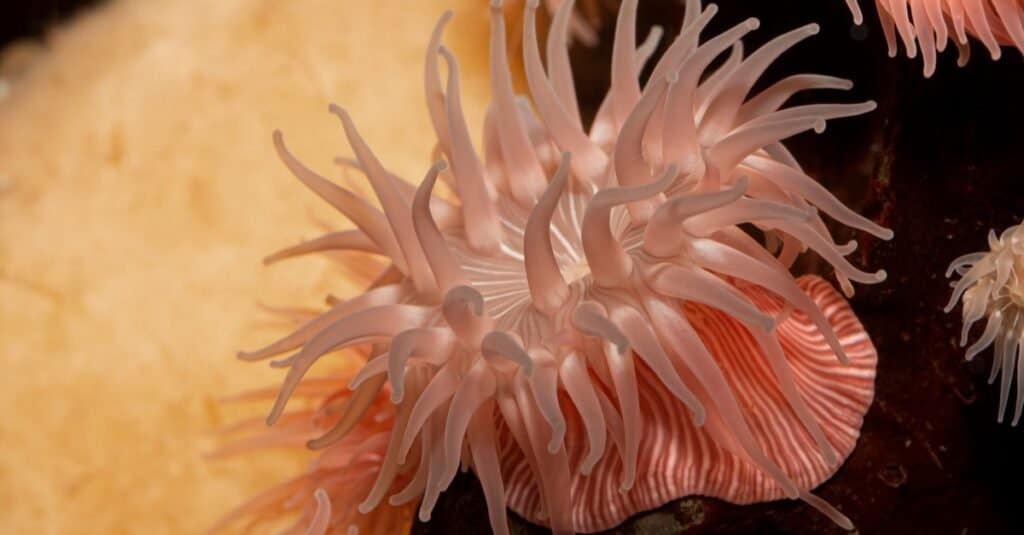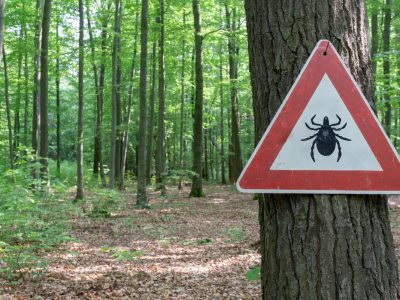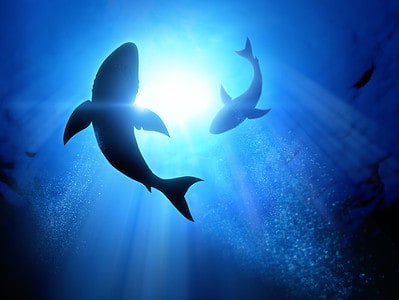Sea Anemone
Creatures have characteristics of both animal and plant
Advertisement
Sea Anemone Scientific Classification
Read our Complete Guide to Classification of Animals.
Sea Anemone Conservation Status
Sea Anemone Facts
- Prey
- Shrimp, small fish
- Group Behavior
- Solitary/Group
- Fun Fact
- Creatures have characteristics of both animal and plant
- Most Distinctive Feature
- Colors
View all of the Sea Anemone images!
The sea anemone is a fascinating, colorful creature. There are over 1,100 recorded species. You’ll find them at depths of over 32,000 feet in oceans all over the globe. Despite this, the biggest and most diverse creatures tend to live in shallow tropical waters. The animal can be transfixing with its rainbow of colors, but trust us, these are not animals to play with.
5 Incredible Sea Anemone Facts!
Here are five interesting facts about these sea animals that demonstrate their unique characteristics and adaptations.
- There are species that live over six decades.
- The sea animal is actually a polyp. It has a columnar trunk that’s topped by a range of tentacles surrounding an oral disc and central mouth. Armed with stinging cells, they use the tentacles to catch unsuspecting prey.
- As harmless and beautiful as they appear to be, the sea creature is a lethal predator.
- The creatures are popular in saltwater aquariums, adding beauty and texture to the environment. For fun, pair the creature with a Clownfish as the two species share a symbiotic relationship.
- In general, sea creatures are not a threat to humankind, but there are toxic species capable of serious injury.
For more interesting sea anemone facts, read ”10 Incredible Sea Anemone Facts”.
Sea Anemone: Classification and Scientific Name
The sea creature got its moniker from the plant of the same name. That’s a terrestrial flowering plant that shares the array of colors you find on a variety of these animals.
This animal is a predatory marine creature. They’re classified as Anthozoa (pronunciation: An·tho·zoa). The creature belongs to the Cnidaria (pronunciation: cni·dar·i·an) phylum and the subclass Hexacorallia (pronunciation: Hex·a·co·ral·la). They are cousins of jellyfish, corals, and tube-dwelling anemones. The family consists of over 1,000 species.
The average sea anemone is no more than a sole polyp attached by its base to a hard surface. But there are species that float near water surfaces (adaptations of bigger creatures) while others live in soft sediment.
The polyp contains a columnar trunk with an oral disc at the top. The disc has a central mouth and a ring of tentacles. The tentacles are retractable, pulling into the body cavity or expanding to trap passing prey.
The creatures have stinging cells which disarm, giving anemones an advantage. Some species live in the proximity of small fish and hermit crabs.
Sea Anemone: The Different Species
There are both wild and recreational creatures among the hundreds of species. Among the families are the Host/Clownfish, Rock/Aiptasiidae, Sea/Actiniidae, Stinging/Actinodendronidae, Tube/Burrowing, and, lastly, what we call the Misc families. Each group has its unique members that encompass over 1,100 species of anemones. Here are a few of each with their scientific names.
Host Creatures
- Delicate sea anemone (Heteractis malu)
- Beaded sea anemone (Heteractis aurora)
- Saddle anemone (Stichodactyla haddoni)
Rock Creatures
- Trumpet anemone (Aiptasia mutabilis)
- Brown glass anemone (Exaiptasia pallida)
- Curlique anemone (Bartholomea annulata)
Sea Creatures
- Christmas anemone (Uriticina crassicornis)
- Giant green anemone (Anthopleura xanthogrammica)
- White-spotted rose anemone (Urticina lofotensis)
Tube Creatures
- Tube anemone (Cerianthus membranaceus)
- Burrowing tube anemone (Pachycerianthus fimbriatus)
- North sea tube anemone (Cerianthus lloydii)
Sea anemones – Misc Families
- Carribean carpet anemone (Stichodactyla helianthus)
- Red bearded anemone (Phymanthus crucifer)
Sea Anemone: Stingers
Anemones sting but not with enough force to hurt most animals, including humans. The average sting only feels sticky to us. Members of the family with strong stings include the Carpet. They are part of the Condylactis genus. There are also Tube anemones in the Pachycerianthus genus.
Some stings result in several reactions, including a rash. The rash can spread fast. If allergic, you can have a severe response. The sting’s known to prompt anaphylactic shock, a shutdown of the respiratory system.
Sea Anemone: What is the Relationship Between Clownfish and Sea Anemones?
The anemones have unique relationships with various organisms and animals. It’s a bond where each creature lives in symmetry with the other. The union provides a region of safe passage for their friends. It’s unique for a predator where anything that moves is potential food.
The clownfish is among those animals hosted by almost a dozen various sea anemones, including the adhesive sea, sebae, saddle, and the magnificent sea anemones (its actual name).
The clownfish is both provided a home and protection by its host. What helps is a skin mucus on the fish that minimizes the stingers. In exchange, the clownfish intervene with potential predators and keeps its host tentacles free of detritus. The creature also feeds on clownfish scraps.
Sea Anemone: Appearance
Among its tens of hundreds of species, you will find these animals in all sorts of environments, in all shapes and colors. Some are a half-inch in size and others are six feet across.
What does unite them is a wide-blossoming, plant-like appearance. But the creature is an invertebrate and kin to coral and jellyfish. It has cylindrical, hollow bodies that sit on a sticky disc. The animal has a central mouth covered by clustered tentacles.

©Ernie Cooper/Shutterstock.com
Sea Anemone: Distribution, Population and Habitat
Here are facts about the world of the sea anemone.
Distribution
The sea creature is a species used by humans only for recreation. In other words, the creature is popular as residents in home aquariums. Otherwise, find them in homes and oceans around the world.
These animals are not on any endangered species list and are not food for anything outside of their ocean predators.
Population
There are over 1,100 species and most are deep in the bowels of the ocean. That makes keeping track of their numbers a task.
Habitat
Depending on the species, the animals are in shallow waters, in rock pools and crevices, under cool, damp rocks, in the sand, on dead coral, and attached to hermit crabs and sea whips. They adopt tropical and temperate seas in low and high currents. The creatures aren’t comfortable in direct sunlight, so often they attach to rocks against the sun.
Sea Anemone: Predators and Prey
The stingers are instrumental in deterring most predators. Thanks to that, most species are fortunate enough to live a non-threatened existence. But some are vulnerable. Sea stars, several species of fish, snail, and sea turtles can get beyond the sea creatures’ security and feed on the creatures.
The animals are carnivorous predators. They eat fish, shrimp, krill, plankton, and anything else that gets too close. The animal’s tentacles react to touch. The appendages shoot off nematocyst, a harpoon-ish filament. It’s a neurotoxin whose characteristics have the potential to paralyze small creatures. Once injected, the prey’s wrapped in tentacles and guided to the mouth.
Sea Anemone: Reproduction and Lifespan
A large number of these animals reproduce through asexual budding. That’s a reproduction process where fragments break off the body and develop into new life.
Other species actually stretch their base and split across the middle. The act results in two new creatures. In yet other families, small bits of tissue break from the creature base and form new, tiny creatures. This is as close to cloning characteristics and reproduction as you get.
The sea creatures can live long lives in the absence of disease or predators. In corners of the scientific community, it’s argued these creatures do not age, can reproduce themselves, and therefore live indefinitely. The truth is the animal has a lifespan of six to eight decades. There is one documented case of a creature living over a century.
Sea Anemone: Recreational Use
The animals are growing in popularity as household pets. But fish aficionados have to approach the project carefully. First, not all types of sea anemones belong outside the ocean. Those that can survive require an exacting habitat. The tanks need specific lighting, oxygen levels, water flows, and other elements to thrive. You have to create and maintain these conditions. It would be a nice idea to pair the animal with a clownfish and watch them live in symmetry.
View all 293 animals that start with SSea Anemone FAQs (Frequently Asked Questions)
What is a sea anemone?
The sea creature is a soft-bodied invertebrate that’s part animal, part plant. It’s a mostly sedentary marine animal found in all oceans.
What does the sea anemone eat?
Sea anemones feed on small fish, crustaceans, sea urchins, and the occasional mollusk.
Where do sea anemones live?
The sea creature thrives in every ocean on the globe. The most diverse and abundant populations have adaptations in shallow tropical waters. Other species live in deep depths below sea level.
Are sea anemones poisonous?
No. They can emit a venom that’s a threat to smaller fish and other marine life, but the majority of stings are not poisonous to humans. BUT there are species known to emit doses of toxin capable of serious injury.
What does a sea anemone do?
The animals have a role in the ecological niche of coral reef communities. For the clownfish and small shrimp, the creatures offer homes and protection from predators. In exchange, the hosts have these guests to keep them clean of parasites.
Can sea anemones be lethal to humans?
No. Most of these creatures lack stinging cells with the force to affect humans. This is not the case with all species though, so be wary. If you were to touch a small creature, you’ll probably have this sticky feeling. That would be the result of the harpoon-like tentacles attempting to eat your finger.
Do sea anemones feel pain?
The sea creature has no brain. As pain registers in the brain and, at that point, the feeling gets transmitted, it is unlikely the animal feels anything.
Is a sea anemone a plant or animal?
A little of both it would seem. A study of the creature’s genes appears to show animalistic characteristics. Yet, the regulatory code that establishes the symmetry of those same genes somehow aligns with those in plants.
Thank you for reading! Have some feedback for us? Contact the AZ Animals editorial team.
Sources
- Marine Biological Association / Accessed September 26, 2021
- Wikipedia / Accessed September 26, 2021
- Britannica / Accessed September 26, 2021
- Ohio State University Bio Museum / Accessed September 26, 2021
- NBC News / Accessed September 26, 2021
- E-Fauna BC / Accessed September 26, 2021
- Pets on Mom / Accessed September 26, 2021


















